“By the Dawn’s Early Light”: Researching War of 1812 Ancestors
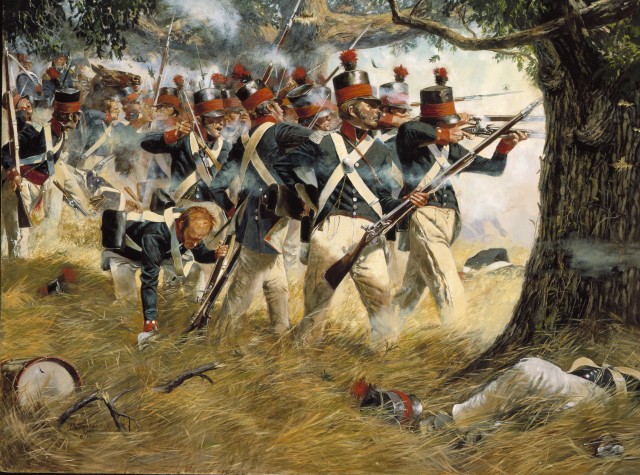
The War of 1812 was a military and naval conflict between the United States (US) and Great Britain over British impressment of American sailors (1803), restriction of American trade with France during Napoleonic Wars (1807), and US desire to expand territory (1811). It has been referred to as “the forgotten war” – most likely because there was no clear winner or loser in the conflict. No lands were gained or lost after the Treaty of Ghent ended the war on February 16, 1815.
Only 7,000 men served in the United States military when the war broke out. By the end of the war, more than 35,000 American regulars and 458,000 militia—though many of these were only mustered in for local defense—were serving on land and sea in the following locations:
- Alabama
- Georgia
- Illinois
- Indiana
- Louisiana
- Maine
- Michigan
- Mississippi
- Wisconsin
- Chesapeake Bay
- Canada
- Lakes Erie and Ontario
Was your ancestor one of those who served?
Who Could Serve?
Before starting your research, you should answer several important questions about your ancestor:
- In what branch of service did he serve?
- Do you know the conflict he fought in or his dates of service?
- If he served in the Army, was it in the Regular Army or a volunteer unit?
- Do you know what state he was living in when he joined the military?
- Did he serve as an officer or an enlisted man?
- Did the veteran, his widow, or a dependent apply for or receive a pension?
- Do you know the conflict he fought in or his dates of service?
Categories of Service
War of 1812 participants fall into six distinct categories of service, which determine the location of records you should look for at either the National Archives and Records Administration in Washington, DC (NARA) or local repositories. Some records may be digitized and available online. They include regular army, state and local militia, and privateers.
- US Army Volunteers –> NARA
- Volunteers: Usually members of state/territorial militia units (either pre-existing or raised specifically for War of 1812) transferred to federal service
- Regular US Army soldiers –> NARA
- Professional, career soldiers: Served continuously in permanent Army during peacetime and in conflicts
- Regular Army infantry regiment recruited from particular state (or states). Rifle, artillery, and dragoons recruited at large
- Members of US Navy –> NARA
- Members of US Marines –> NARA
A list showing the locations of regimental recruiting districts is available at Google Books, the Internet Archive, and HathiTrust in William A. Gordon, A Compilation of Registers of the Army of the United States, from 1815 to 1837, under “Officers.”
These categories fall under state, local militias, and privateers:
- Members of state/territorial militia that were never joined to the US Army –> State and private archives and historical societies
- Some of these militias were joined to volunteer US Army
- Others guarded cities, harbors, and towns within their own state, and records of latter will be hold in local repositories
- Privateers –> Few records survive, but some information is available in the articles ”Yes, Privateers Mattered” and War of 1812: Privateers.
At the time of the War of 1812, each state and territory normally already maintained a militia of male citizens organized to quell disturbances.
Additional resources may be found in the articles ”Genealogical Records of the War of 1812” and ”Genealogical Fallout from the War of 1812”. The latter discusses seamen’s protection certificates.
Army Officers
When researching army officers, researchers should first consult Francis B. Heitman’s Historical Register and Dictionary of the United States Army, From Its Organization, September 29, 1789, to March 2, 1903. Volume 1 is a register of army officers and provides a brief history of each man’s service. Volume 2 contains a “chronological list of battles, actions, etc., in which troops of the Regular Army have participated and troops engaged.“
If the officer attended West Point, you should check the database “U.S. Military Academy Cadet Application Papers, 1805–1866” in Fold3.com or Fold3 Library Edition, and Ancestry.com or Ancestry Library Edition, and “Records Relating to the U.S. Military Academy, 1812–1867.” The latter group, however, is at NARA in Washington, DC. Grapevine Library provides access to Ancestry and Fold3 free of charge.
Army Enlisted Men
The place to start researching enlisted men is “Regular Army Enlistment Papers, 1798–1894.” These are not digitized. They are arranged alphabetically by name of the soldier. They generally show the soldier’s name, place of enlistment, date, by whom enlisted, age, place of birth, occupation, personal description, regimental assignment, and certifications of examining surgeon and recruiting officer. Soldiers usually have multiple enlistment papers if they served two or more enlistments. You should consult “Register of Enlistments in the U.S. Army, 1798-1914,” digitized on Fold3.com and Fold3 Library Edition (Fig. 1). It documents from enlistment to termination of service and includes name, rank, regiment, dates of enrollment and discharge. It may include physical description, birthplace, age, occupation, remarks regarding transfers, courts-martial, and reasons for discharge, including death.

War of 1812 resources on Fold3 include 41 collections under “War of 1812 – (United States).” You can filter by publication type, record type, and service branch and access them for free (Fig. 2).
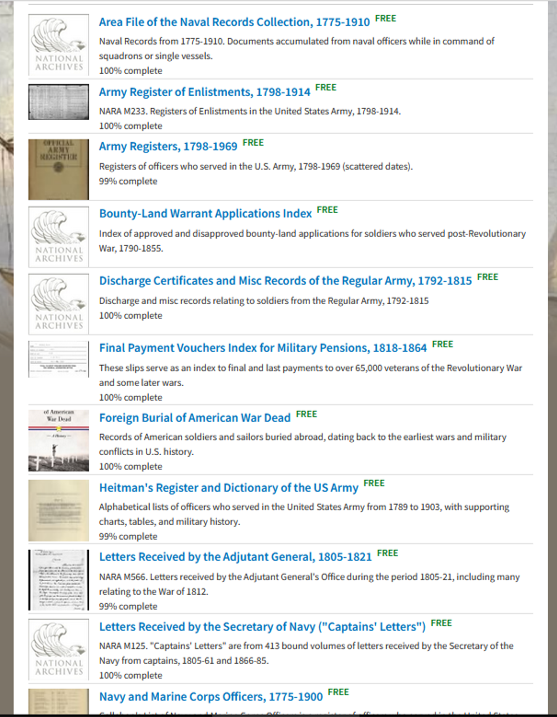
Resources including War of 1812 information at Ancestry can be found in a couple of ways. First, you can go to https://www.ancestry.com/search/categories/war_1812/ to get the entire list (Fig. 3), or go to the card catalog and use the filters “Keyword -> 1812-> Military -> USA -> (State).”
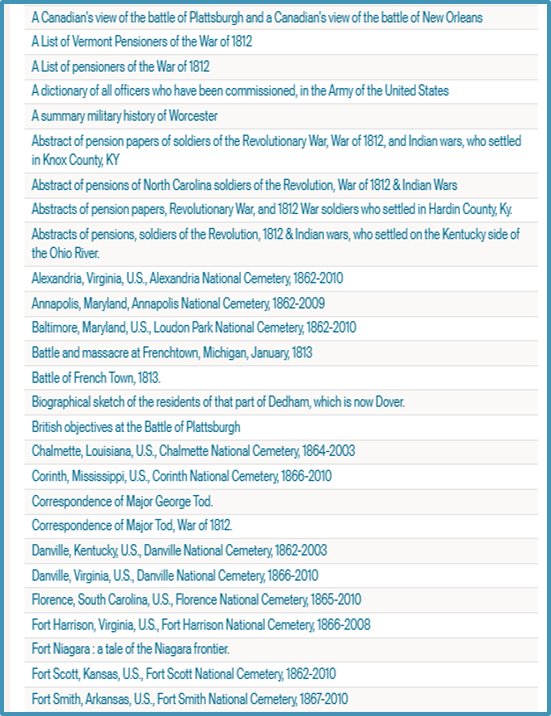
information. Ancestry.com.
Muster rolls for War of 1812 soldiers and sailors are only in text format and not available online. They are in the group “Muster Rolls of Volunteer Organizations During the War of 1812, June 18, 1812–February 17, 1815.” The Library of Virginia has a muster roll and payroll index containing approximately 40,000 names of Virginia militia soldiers from various sources.
FamilySearch, a free database accessible to everyone, contains a wealth of information about, and links to, US records from the War of 1812, including state records. You’ll need to set up a free login and password to view actual records.
Compiled Service Records
The War Department did not compile military service records for those who served in the Regular Army. Service records for War of 1812 soldiers are not online (except for Mississippi at Fold3; see Fig. 4) and must be obtained from the National Archives. FamilySearch provides an index to compiled service records; Ancestry also has one. The web site Online War of 1812 Indexes and Records has links to national and state indexes to service records.
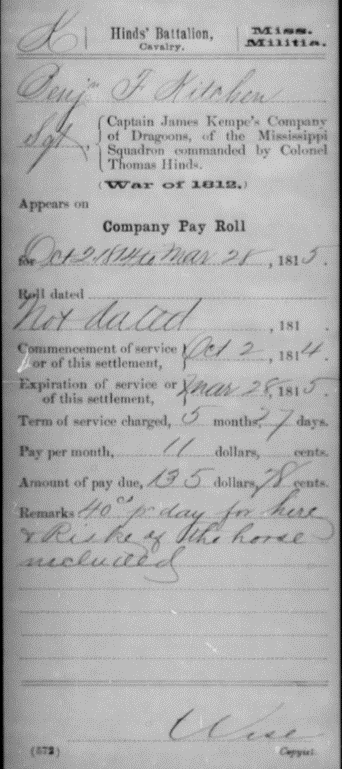
Fold3.
War of 1812 Discharge Certificates
Most discharge certificates remained in private hands. They are usually difficult to locate and seldom available for public research but may be in a soldier’s bounty land warrant application. The one exception is small series of extant discharge certificates and other records relating to over 2,200 Regular Army soldiers from 1792-1815 (Fig. 5). The majority of these records provide otherwise unavailable source of information for service during the war. They are ONLY on microfilm at all National Archives branches as M1856, Discharge Certificates and Miscellaneous Records Relating to the Discharge of Soldiers from the Regular Army, 1792-1815.
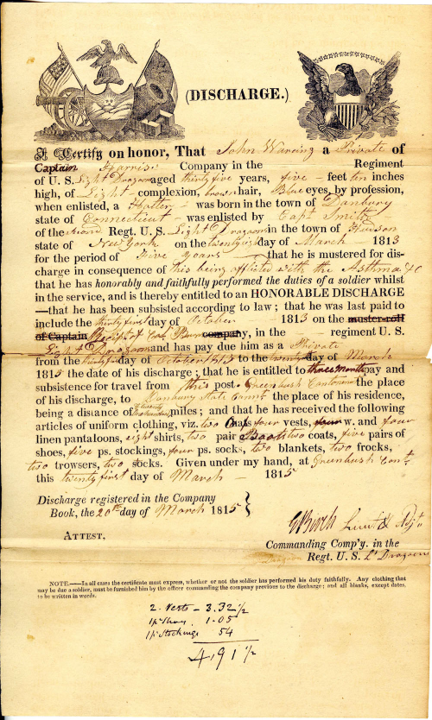
Warring of Connecticut.
Pension and Military Bounty Land Warrant Applications
Pension applications are probably the most sought-after documents genealogists look for because they not only document a soldier or sailor’s service; they can also provide valuable genealogical information (Fig. 6). You can find them on Fold3 where they are alphabetically arranged; the index is complete but currently the files are only 85 percent complete. Bounty land warrant warrants were issued between 1815 and 1858 under various acts of Congress (Fig. 7). Before 1842 they had to be used in public land districts in Arkansas, Missouri, or Illinois. Soldiers could select the district but not the plot of land. Some warrants list heir’s/heirs’ name(s) and relationship to the deceased veteran. Over 2,400 warrant applications have been digitized and placed online in the NARA catalog.
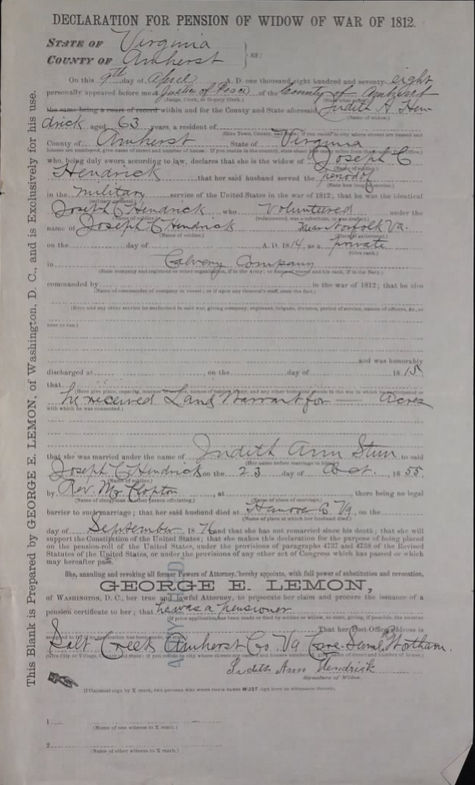
Joseph C. Hendrick, of Amherst Co., Virginia. Fold3.com.
“Unindexed” Bounty Land Applications
Not all bounty land applications are found in the pension file collection mentioned above . Some applications were cancelled because the applicant did not qualify. If the applications were not approved, they would be found in “Case Files of Bounty Land Warrant Applications Based on Service Between 1812-1855 and Disapproved Applications Based on Revolutionary War Service” These are commonly called Unindexed Bounty Land Applications. They include approximately 360,000 application files, including rejected ones. Files of surnames from A to L are partially indexed on Fold3. You can request copies of federal military records at NARA; use this form or order online.
Did Your Veteran Apply?
To see if your 1812 veteran applied for bounty land, check the Bureau of Land Management General Land Office Records, which provides information on land transfers. If he received a land patent issued on the basis of military service, there should be a bounty land warrant application. The BLM site does not reference rejected applications since no patent was issued.
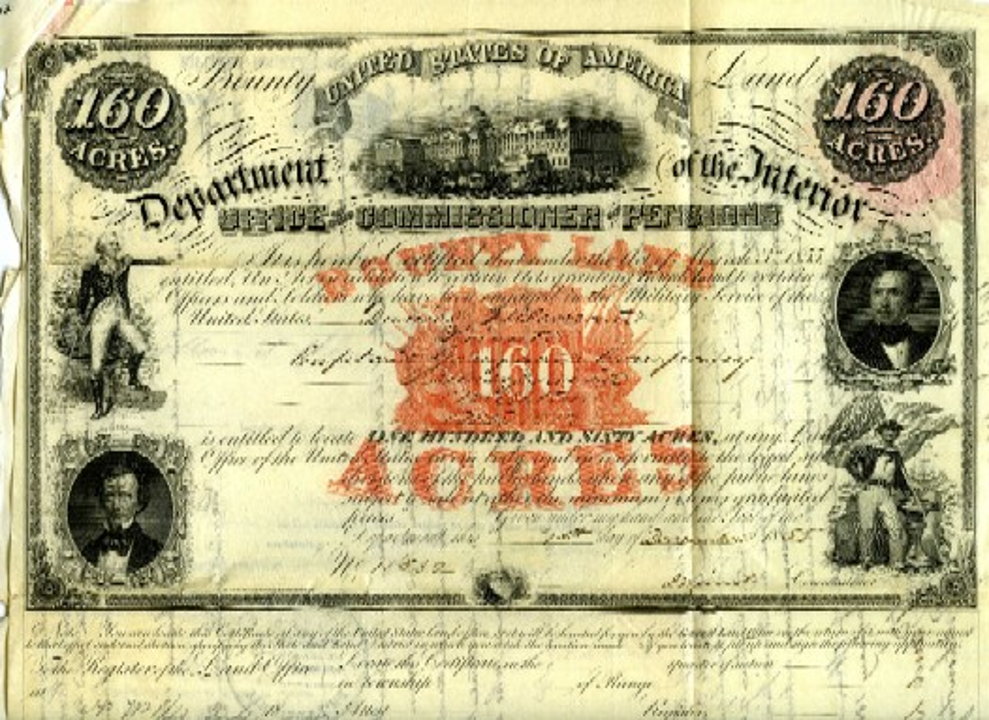
War of 1812.
Regimental Histories
You can find regimental histories of War of 1812 units online in several places. Cyndi’s List provides links, as does The Online Books Page. Google, Google Books, Internet Archive, and HathiTrust are also good resources to locate these histories. Some state repositories like the Tennessee State Library and Archives have posted histories of their 1812 regimental units (Fig. 8).
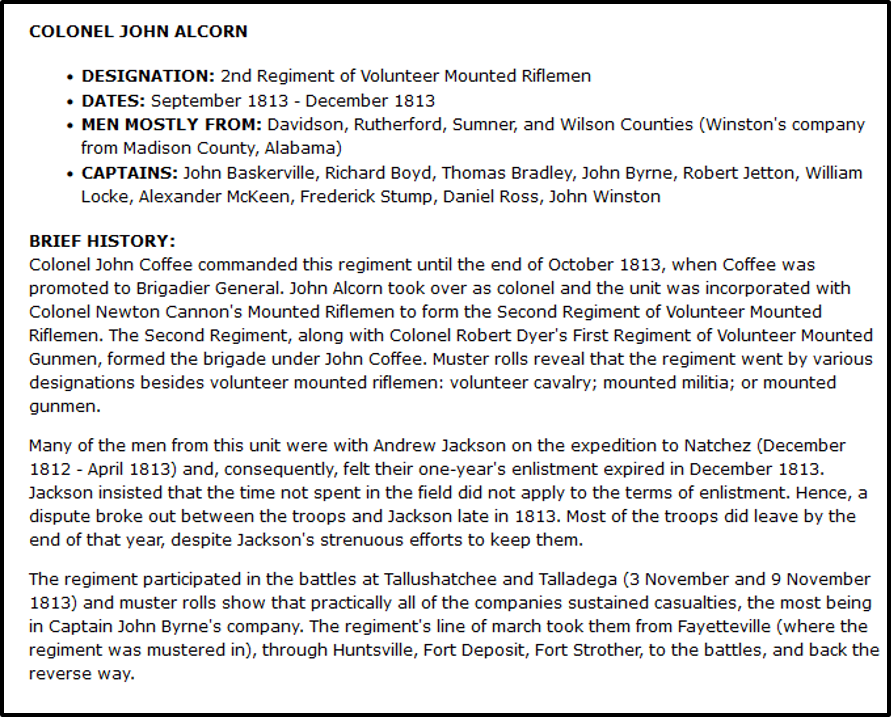
Riflemen. Tennessee State Library and Archives.
NAVAL RECORDS
Records of naval officers’ service are more numerous than those for enlisted personnel
The best sources for ascertaining naval service are pension and bounty land application files.
If a seaman applied for one of these benefits, the ship’s name and dates of service will be indicated on the application, making the search for pertinent muster rolls less time-consuming.
Registers of the Navy give the sailor’s name, rank, pay, and rations, of each commissioned officer and midshipman belonging to the navy (Fig. 9). Edward W. Callahan’s List of Officers of the Navy of the U.S. and the Marine Corps From 1775 to 1900 is free at FamilySearch and Fold3. It Includes the General Navy Register, containing alphabetically arranged names of all Navy officers from 1798-January 1901, and may include additional brief information about them.
Two non-digitized NARA microfilm publications contain information on impressed seamen, 1793-1814: M2025, Registers of Applications for the Release of Impressed Seamen, 1793-1802, and Related Indexes (1 roll), and M1839. Miscellaneous Lists and Papers Regarding Impressed Seamen, 1796-1814 (1 roll).
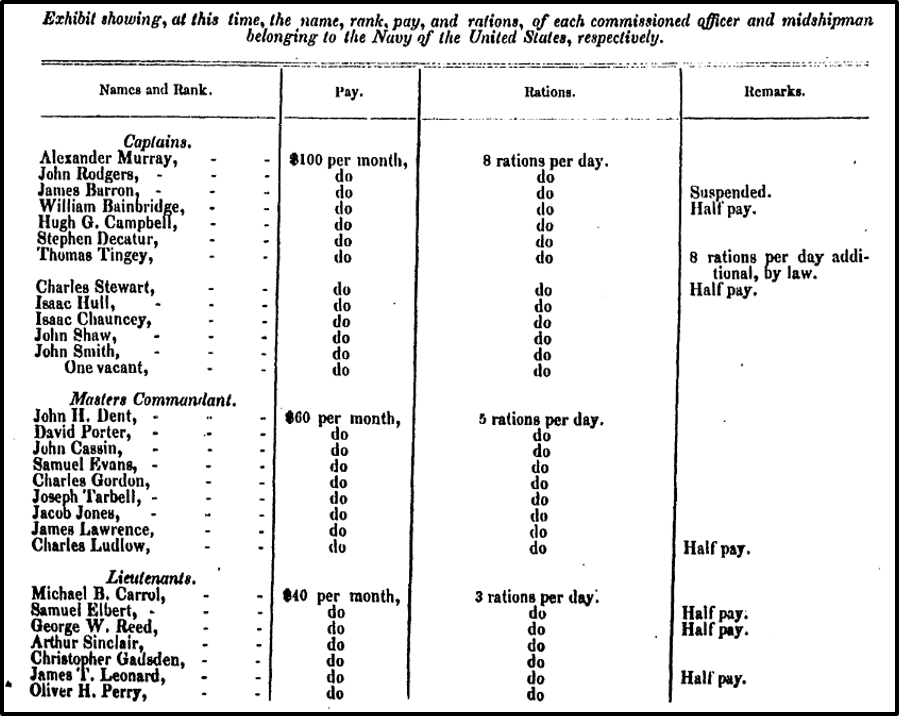
MARINE CORPS RECORDS
Like naval officers, the basic National Archives record showing Marine Corps officer War of 1812 service can be found in the NARA publication M330, Abstracts Of Service Records of Naval Officers (“Records of Officers”), 1798 – 1893. It is not digitized. Volumes D and E in this set show officers’ records of War of 1812 service. Entries are arranged chronologically and give dates of acceptance, resignation, appointment, assignment, transfer, promotion, and ships on which an officer served.
Records of the U.S. Marine Corps (Record Group 127) include comprehensive card indexes listing all officers and enlisted men who served before 1900. They are not digitized. Information is slim, but records show dates of appointment and enlistment. However, service records exist for enlisted Marine Corps personnel, 1798-1895. They are arranged by year of enlistment, thereunder by initial letter of the surname, and consist of enlistment and other papers that might establish the date of service, age, place of birth, and occupation. The U.S. Marine Corps Muster Rolls, 1798-1958 collection contains an index to U.S. Marine Corps muster rolls covering 1798-1958. Records show name, rank, enlistment date, muster date, station, and are on Fold3, Ancestry, and free at FamilySearch (FamilySearch only to 1937).
NON-MILITARY SOURCES OF WAR OF 1812 GENEALOGICAL INFORMATION
Two non-military resources to know about are newspapers and personal diaries or journals. Check free newspaper databases such as Chronicling America and the newspaper portal at The Ancestor Hunt as well as library edition databases Newspapers.com and NewspaperArchive to locate contemporary information about battles your ancestor was in. Some state and local organizations have also digitized papers published in their states. You may find printed copies of letters from officers and government officials describing events (Fig. 10). You can then compare the battle account with someone’s compiled service record. If your ancestor was pensioned, compare his account of participation to a published account. Doing this adds colorful depth and detail to family narratives.

(Richmond, Virginia), p. 2.
Chronicling America.
If someone in your ancestor’s regiment kept a diary or journal but your ancestor didn’t, you can still have an account of the event. These accounts may have been published separately or even in scholarly journals. Individual writings may come up in Google searches by entering “diaries + journals + “war of 1812“ in the search box. One such search found Journals and Diaries Kept by Pennsylvanians During The War of 1812. Also consider searching the Internet Archive, Google Books, and HathiTrust. An Internet Archive search revealed A Journal of Two Campaigns of the Fourth Regiment of U.S. Infantry in the Michigan and Indiana Territories, Under the Command of Col. John P. Boyd, and Lt. Col. James Miller during the Years 1811 &12 (Fig. 11).
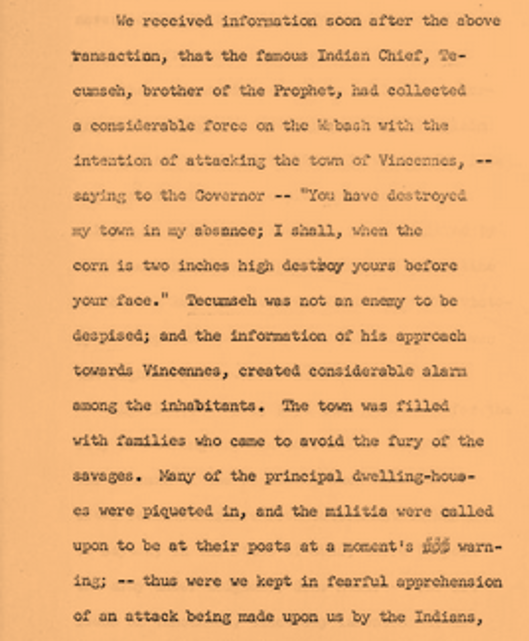
Regiment of U.S. Infantry in the Michigan and
Indiana Territories, Under the Command of Col.
John P. Boyd, and Lt. Col. James Miller during the
Years 1811 & 12, by Adam Walker, 1900.
Internet Archive.
Genealogically preserving our War of 1812 heritage is an important part of keeping this conflict and those who fought in it from being known as “forgotten soldiers and sailors of the forgotten war.” Use these fantastic resources to identify your War of 1812 ancestor!





Recent Comments